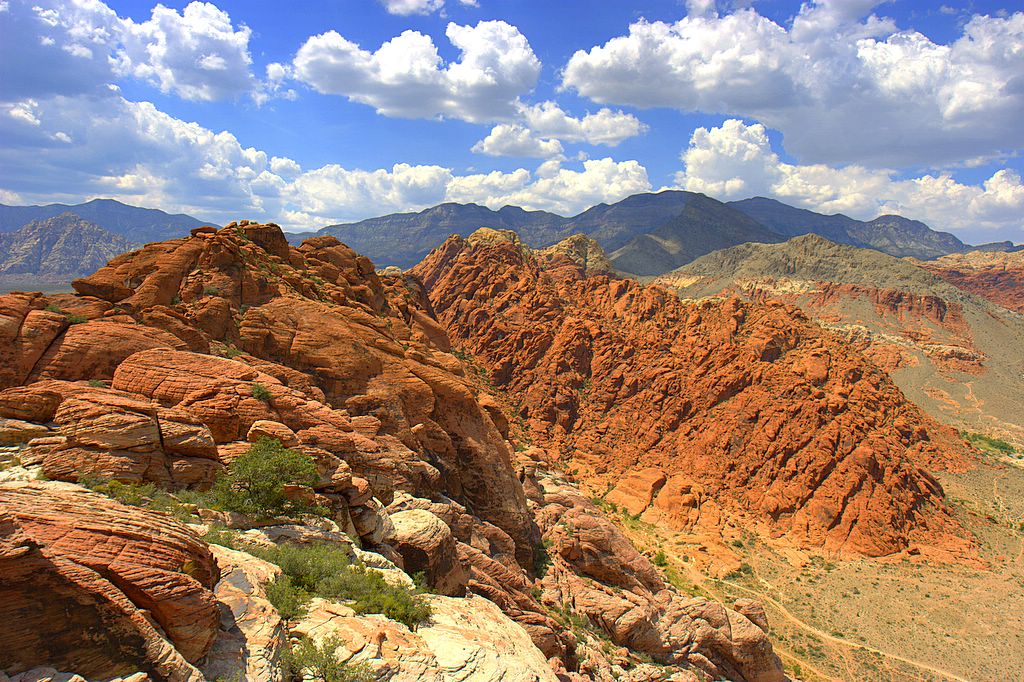Featured image: a view of the Calico Basin in the eastern part of the Mojave Desert. Photo by Fred Morledge, CC BY-SA 2.5, via Wikimedia Commons.
Paper: Thin crème brûlée rheological structure for the Eastern California Shear Zone
Authors: Shaozhuo Liu, Zheng-Kang Shen, Roland Bürgmann, & Sigurjón Jónsson
A recent paper by Liu and colleagues aims to answer a fundamental question in geodynamics: are Earth’s tectonic plates more like a jelly sandwich, or a crème brûlée? It may sound silly, but these two models for crustal strength describe how tectonic plates might respond to stress changes due to earthquakes.
The most noticeable part of an earthquake is the ground shaking right after a fault slips, but the changes in local and regional stresses due to that fault slip persist and cause what is known as postseismic deformation. This deformation is evident in geodetic records of slow ground motion that continues for months, years, and even decades after a large earthquake as the crust and uppermost mantle relax into a post-earthquake equilibrium. In one famous and well-studied example from California, postseismic deformation from the 1992 Landers earthquake is thought to have triggered the 1999 Hector Mine earthquake as changes to the regional stress field slowly propagated out from the Landers epicenter.
Scientists studying postseismic deformation are faced with the difficult problem of trying to understand the rheologies of the crust and uppermost mantle – how these layers deform in response to stress – based solely on measurements of how the ground moves up and down. In the classic jelly sandwich model, a weak (or low viscosity) lower crust deforms by flowing ductilely between two much stronger (higher viscosity) layers of upper crust and uppermost mantle. The crème brûlée model, in contrast, posits a weaker mantle topped by a crisp crust. These two types of models predict subtly different patterns of postseismic deformation.
Liu and co-authors tackle this puzzle using measurements of ground motion over time from the Mojave Desert, where the Landers, Hector Mine, and 2019 Ridgecrest earthquakes all occurred. Using data from before the Landers earthquake, the authors established how the region was deforming pre-earthquake, enabling them to distinguish between postseismic deformation and the background rate. They then modeled the postseismic component of the deformation using a typical three-layer model with different viscosities for the upper crust, lower crust, and uppermost mantle.
The authors found that the postseismic deformation signal for the Mojave Desert is best explained by a crème brûlée model. However, in contrast to previous studies that posited a strong lower crust as well as upper crust, this new study finds that the lower crust is nearly as weak as the upper mantle, leaving just the upper crust as the thin caramel lid on the crème brûlée. The data also indicate that the weaker layers slowly get stronger as time passes after an earthquake, like a custard that sets more firmly as it cools.
Liu and co-authors demonstrated that the crème brûlée model fits the Mojave region, but in other places, like the Himalayas, there’s evidence that the jelly sandwich model is a better fit. While we know that the Earth’s crust is not actually made of caramel, custard, bread, or jelly, mapping out its actual rheology remains a challenging problem. Lately, though, some scientists have proposed a new “banana split” model for crustal structure, so interesting (and tasty) new studies are sure to come soon.
Cracking the code of the caramel crust by Hannah Mark is licensed under a Creative Commons Attribution-ShareAlike 4.0 International License.

